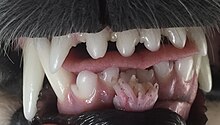Papilloma
| Classification according to ICD-10 | |
|---|---|
| D14.0 | Benign neoplasm in the middle ear, nasal cavity, and paranasal sinuses |
| ICD-10 online (WHO version 2019) | |
The papilloma is a benign tumor that originates in the uppermost layers of the skin or mucous membrane of an organism. Papillomas are found, for example, on the skin of the body surface, in the urinary tract, in the ducts of the female breast and other glands or on the mucous membranes of the mouth, nose, sinuses or in the gastrointestinal tract (villous adenoma). Papillomas have a cauliflower-like appearance and can grow up to 1 cm in size. The histological examination reveals a vascular, finger-shaped ramified stroma with a regular superficial squamous epithelium. Virus infections or mechanical irritation are suspected to be the cause.
Papillomas of the skin
Skin papillomas occur in all age groups with no gender preference. Cosmetically disturbing growths can be surgically removed.
Papillomas of the mucous membrane
Nose and sinuses
Mucosal papillomas , also called Schneider papillomas , are rare, predominantly benign tumors of the nose and paranasal sinuses (inverted or transitional papillomas) and usually occur on one side , which distinguishes them from bilateral inflammatory sinusitis . Symptoms are (one-sided) headache, especially obstruction to nasal breathing and sometimes nosebleeds. The inverted papilloma is mostly located on the lateral nasal wall, but it can also sit on the nasal septum or arise from the paranasal sinuses, such as the maxillary sinus and ethmoid bone . Although it is not a malignant disease, the change must be radically removed surgically, otherwise it can grow into surrounding organs such as the eye socket.
The inverted papilloma, macroscopically with a smooth surface, spreads endophytically below the level of the mucous membrane and displaces the surrounding tissue structures . A mulberry-like surface is also typical . Upon inspection, the tumor is yellowish to salmon-colored with a grayish-white cut surface. The inverted papilloma bleeds easily when touched. The medical proper name of the Schneider papilloma is derived from an area of the nasal mucous membrane that, in terms of development, corresponds to the Schneider membrane . The Schneider membrane develops at the end of the fourth week of embryonic development , is derived from the olfactory placodes and is therefore of ectodermal origin in contrast to the other endodermally derived respiratory mucosa .
See also
Web links
- Bladder papilloma histology on PathoPic
- Papilloma in the oral mucosa on DermIS
- Urinary bladder papilloma on PathoPic
Individual evidence
- ↑ Uwe Ganzer, Karl Donath , Rainer Schmelzle: Tumors of the inner nose, the nasal sinus, the upper and lower jaw. Special part. Papilloma. In: Hans Heinz Naumann, Jan Helms, Claus Herberhold , Ernst Kastenbauer (eds.): Oto-Rhino-Laryngology in Clinic and Practice. Volume 2: Ernst Kastenbauer (Ed.): Nose, paranasal sinuses, face, oral cavity and pharynx, head salivary glands. Thieme, Stuttgart et al. 1992, ISBN 3-13-676601-6 , p. 236 ff.
- ↑ Heinz Stammberger: New aspects on the genesis of the inverted papilloma - first communication. In: Laryngo-Rhino-Otology. Vol. 62, No. 6, 1983, ISSN 0340-1588 , pp. 249-255, doi: 10.1055 / s-2007-1008425 .

